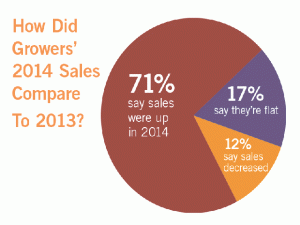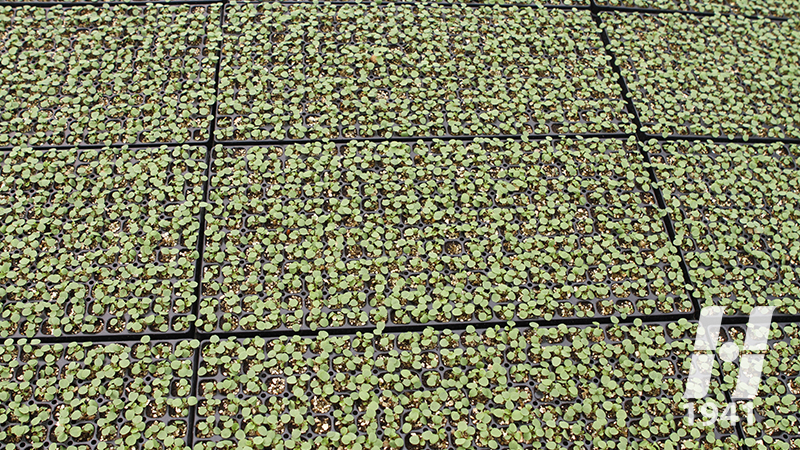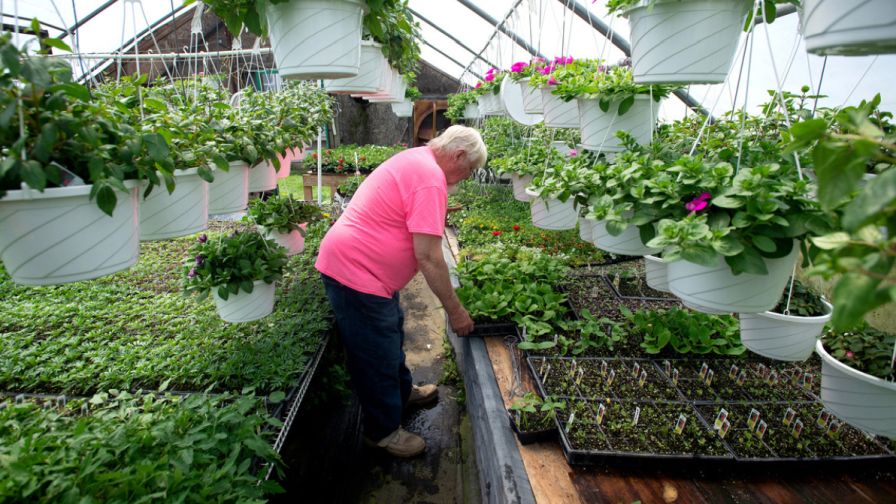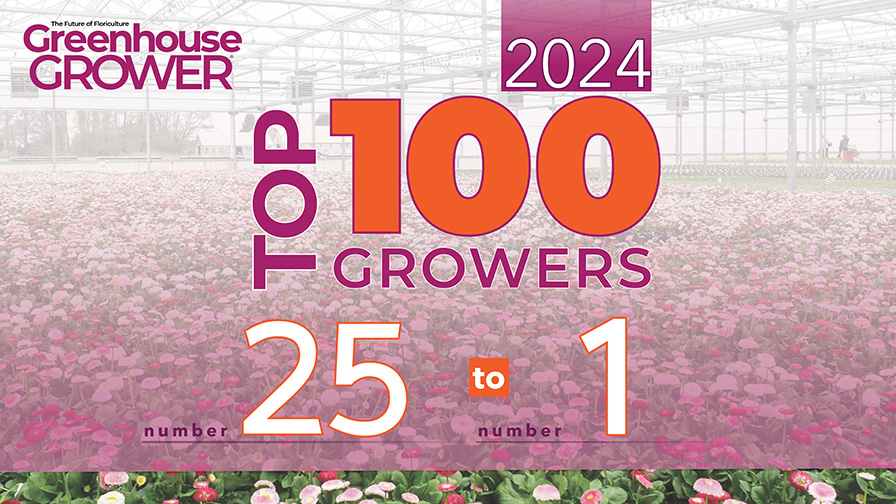Growers Are Optimistic For A Strong Year In 2015
 Every new year offers a fresh start, but in 2015, growers and suppliers are feeling particularly hopeful. After the past few years’ slow climb back to what seems like an economic recovery, Greenhouse Grower’s 2015 State Of The Industry Survey reveals that the industry is poised for a year of growth.
Every new year offers a fresh start, but in 2015, growers and suppliers are feeling particularly hopeful. After the past few years’ slow climb back to what seems like an economic recovery, Greenhouse Grower’s 2015 State Of The Industry Survey reveals that the industry is poised for a year of growth.
It’s not all sunshine and roses, however. Growers know they face some hurdles, including increased production costs, and they are still concerned over the economy and changes in government regulations, among other things. But overall, the survey numbers are positive
The 253 grower respondents to our survey included wholesale growers, grower-retailers and young plant growers of all sizes from across the industry. The survey also included a section with questions for vendors (see “Suppliers Will Increase Prices, Grower Education For 2015”).
Seventy-one percent of our grower respondents report their 2014 sales grew over 2013. That seems to have fueled their optimism, with 73 percent of growers saying they expect to increase production volume in 2015, while 30 percent will keep their production volume the same. To house that growth, 42 percent of growers say they plan to add or retrofit a greenhouse structure this year.
Growers are getting bolder, too, as 49 percent of growers say they are planning to increase their prices in 2015, while an equal percentage will keep prices flat. That’s a change from 2013, when 62 percent of our survey respondents said they planned to keep prices flat, and from 2012, when 58 percent anticipated flat prices.
 Growers Are Focusing On New Markets, Plant Uses
Growers Are Focusing On New Markets, Plant Uses
In the past two years, we’ve seen growing interest in production of greenhouse vegetables, but this year, that interest seems to be settling. Whereas in 2014, 43 percent of growers said they planned to increase vegetable production, up 5 percentage points from 2013, only about a third of growers — 35 percent — plan to grow produce in 2015. Breaking that number down, 42 percent of small growers will grow produce, while their medium (26 percent) and large (24 percent) grower counterparts are less interested.
Still, herbs and vegetables specifically (compared to produce) were named as a growth area, with 45 percent of growers saying they’d increase production of those crops in 2015. But herbs and vegetables were the largest area of decrease among large growers, with 29 percent saying they’ll reduce that category in 2015.
Meanwhile, medical marijuana is another market gaining interest among growers of all sizes. While most growers don’t plan to pursue the medicinal crop in 2015 (2 percent say they will), 20 percent of growers say they may look at the crop in the next few years, but 78 percent say they aren’t interested.
Container perennials are a growing category, with 40 percent of growers saying they plan to increase production this year. Ornamental bedding plants will increase overall, with 39 percent of growers expanding production, though this is mainly among larger growers. Small and medium-sized growers plan to reduce this category in favor of container perennials. Look for flowering potted plants to grow, as well, with 31 percent of growers increasing production.
Use Of Neonicotinoids Will Vary Among Growers Of Different Sizes
With continued concern about pollinator health and research to determine to what degree pesticides affect pollinators still inconclusive, growers have made their own decisions about how  to proceed with growing their crops for the 2015 spring season. Overall, 52 percent of growers have decided not to use neonicotinoids this year, while 48 percent will continue using the chemicals. The numbers vary depending on grower size. Sixty-two percent of small growers have decided not to use neonics, while 45 percent of medium growers and 30 percent of large growers will seek other solutions.
to proceed with growing their crops for the 2015 spring season. Overall, 52 percent of growers have decided not to use neonicotinoids this year, while 48 percent will continue using the chemicals. The numbers vary depending on grower size. Sixty-two percent of small growers have decided not to use neonics, while 45 percent of medium growers and 30 percent of large growers will seek other solutions.
Many growers who commented said they are working toward using fewer chemicals in general, and increasing the use of beneficial insects and biocontrols. But they also said neonics will still be used if necessary.
Among smaller growers, many said they haven’t used neonics and don’t plan to, either because they grow organically or don’t have a need. Other small growers said they opted not to use neonics in 2015 due to customer complaints or to avoid any emotional conversations with customers.
Growers who keep bees, however, were among those who said they’ll continue using neonics.
“I’m also a beekeeper and I don’t think that neonics are a large threat to bees when used on the current hybrid ornamentals because most of these flowers are not inviting to bees because of their lack of quality nectar,” says Merlin Weaver of Weaver’s Farm Market.
John Schoustra of Greenwood Daylily Gardens says, “We host hundreds of beehives on our grounds during the winter. Our beekeeper is less concerned about neonics than about lack of access to stronger chemicals to use against the varroa mite. These chemicals are available to Australian beekeepers.”
“We are beekepers but we understand the need to keep this class of pesticides available,” says Maureen Murphy of Murphy Johns, Inc., a medium-sized grower.
Several medium and large growers said they will continue to use neonics on a limited basis.
“We will do everything possible to reduce, but to do without simply increases usage of more toxic chemicals, which are less effective,” says Stan Van der Waal of Rainbow Greenhouses.
Abe Van Wingerden of Metrolina Greenhouses agrees, saying, “We are still testing multiple alternatives, but crop quality and health cannot be compromised in this process. We follow all required application and usage instructions and we limit the use of all chemicals to the bare minimum need. That has always been and will always be our direction.”
Neonics are harder to eliminate in some crops than others.
“I use biologicials in my IPM program, but use a neonicotinoid systemic on finished tropicals when they are shipped in,” says Patti Bogler of My Nest Greenhouse, a small grower-retailer. “The tropicals are bug magnets and the customer wants a plant they don’t have to treat constantly for insects.”
Real World Concerns Balance Grower Optimism
Along with the debate over using neonics, government regulation ranks high on the list (at No. 3) of concerns growers have going into 2015, including the Affordable Care Act, pesticide regulation, labor laws and transportation challenges.
“Immigration issues literally keep me up at night,” says Andreya Daubman, a recently self-employed grower-retailer. “There are many people who are integral parts of this industry and key people in the companies where they work, or that they own, whose status in this country is still tenuous in spite of living and working here for 10 years or more, while trying every option to adjust their status.”
“Obamacare will be a burden, and it is scary,” says Randy Strode of Agri-Starts, Inc.
Paul Westervelt of Saunders Brothers, Inc., agrees, saying, “How do you plan when the rules change constantly? (The Affordable Care Act) will cost us much more next year and we have to commit to a year-long decision, when the rules may change again three days after the deadline. It’s maddening.”
David Holley of Moss Greenhouses says, “Government regulations are all over the board with many of us not knowing what our options are to keep legal. Until such a point this is clearly defined, it will be hard to run our operations effectively and profitably.”
Like last year, the top concern on growers’ minds is production costs, and although the economic outlook for 2015 looks rosy, the economy is still high on the list of worries for growers.
“The banking industry is slow to keep up with the cash flow needs we have,” says Jeff Prior of Dakota Greens and Custer Greenhouses & Nursery, Inc. “I turned more than 100k of additional business away this past season because of the lack of cash.”
Betty Bless of Prairie Nursery says the tentative nature of the economy is troubling.
“We’re seeing positive signs but it’s not really feeling like it’s an all-out recovery yet,” she says. “It’s still unknown if we will slide back into recession.”
Growers are working hard to combat some of the toughest business issues they’re facing, including transportation mandates and high shipping costs and the ever-present challenge of finding enough qualified labor.
“Transportation has quickly moved to the top of the list of concerns as increasing DOT regulations and the aging of the CDL licensed population are both worrisome topics,” Van Wingerden says. “We are actively working on new and innovative solutions to this issue, but it will take time and additional investment to find the right longer-term solutions.”
Danny Gouge of Willoway Nursery says, “Labor is a big expense that affects the bottom line, so we have to monitor this closely to be sure that we are using it effectively. We are always watching production costs and have a lean management program in place to use resources and supplies effectively.”
The changing customer base is an ever-present concern for growers. But it seems the time is ripe for industry collaboration on messaging to the consumer. Growers have a lot of ideas on how to do this.
“We are providing more specific information about neonicotinoids and bees, and crop information on our website, coming out in the very near future,” says George Lucas of Lucas Greenhouses.
Charles Schwer of Mountain State Seed Co. says, “We educate the public on the benefits of plants in our lives. Plants are pollution fighters.”
Growers Are Ready To Conquer 2015
Despite growers’ concerns and misgivings, the new year and season provides a spirit of renewal that echoes throughout growers’ answers in response to the question, what are they most excited about for 2015? The most common answer: “getting” to wipe the slate clean and grow for another season.
Jeff Marstaller of Cozy Acres Greenhouses put it best, “Aren’t we all the eternal optimists, planting seeds when the temps are below zero and there is 3 feet of snow? I love the promise of spring.”
Read what suppliers had to say in “Suppliers Will Increase Prices, Grower Education For 2015.”
See more 2015 statistics in “State Of The Industry 2015: Numbers At A Glance.”










